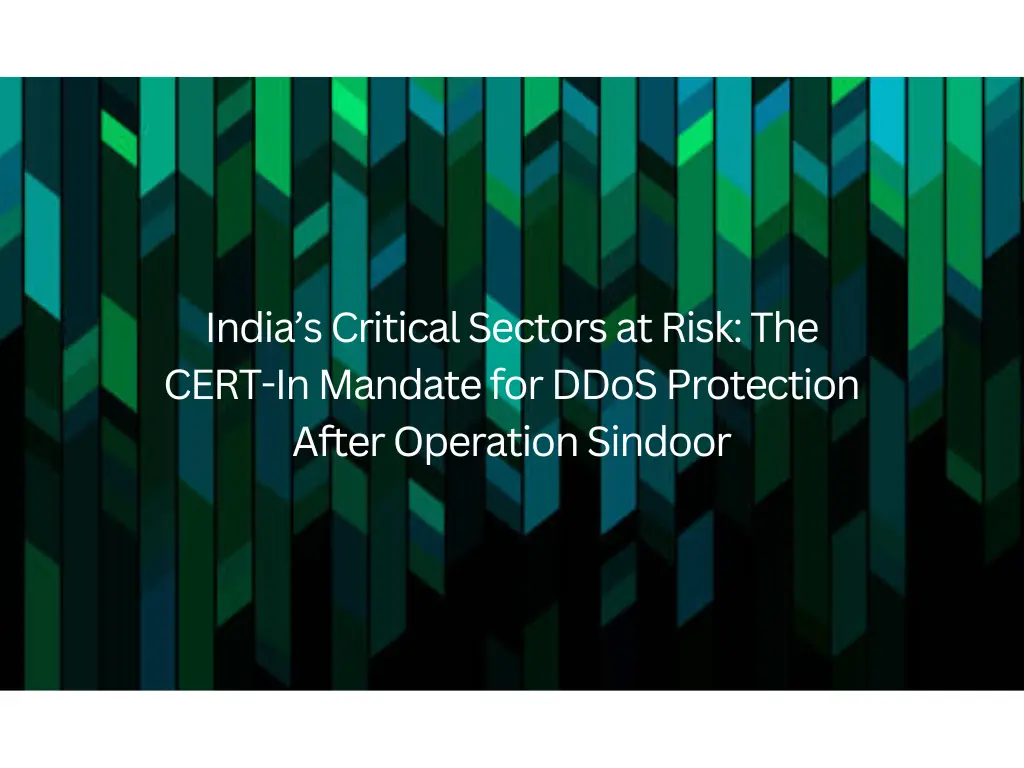Introduction: A Wake-Up Call for Cybersecurity
The recent terror attack in Pahalgam, followed by CERT-In’s urgent advisory on #OperationSindoor, has exposed a chilling reality: India’s critical infrastructure is under siege by cybercriminals. With Distributed Denial-of-Service (DDoS) attacks surging as a weapon of disruption, sectors like healthcare, banking, energy, and government services are now prime targets.
But what makes DDoS attacks so dangerous? And how can organizations shield themselves in this high-stakes cyber battleground? Let’s decode the threat and arm your business with actionable defences.
Understanding the DDoS Threat Landscape
What is a DDoS Attack?
A DDoS (Distributed Denial-of-Service) attack floods a network, server, or application with massive fake traffic, overwhelming resources and causing outages. Think of it as a digital tsunami—crippling operations, eroding customer trust, and costing millions in downtime.
Why Critical Sectors Are Vulnerable
- Healthcare: Patient data and emergency services disrupted.
- Banking: Financial transactions frozen, leading to panic.
- Energy: Power grids destabilized, risking national security.
- Government: Sensitive citizen data leaks and service paralysis.
Operation Sindoor: A New Threat Horizon
The Pahalgam terror attack has intensified concerns about asymmetric warfare, where cyberattacks amplify physical threats. CERT-In’s advisory highlights attackers exploiting vulnerabilities in outdated security systems to launch multi-vector DDoS campaigns.
CERT-In’s Advisory – Key Takeaways
The Indian Computer Emergency Response Team (CERT-In) has urged organizations to:
- Audit Network Infrastructure: Identify weak points in firewalls, servers, and IoT devices.
- Adopt Real-Time Monitoring: Detect anomalies before attacks escalate.
- Implement Advanced Mitigation Tools: Move beyond legacy systems to AI-driven solutions.
- Prepare Incident Response Plans: Ensure 24/7 readiness for rapid recovery.
Non-compliance isn’t just risky—it’s a liability.
Why Traditional Security Fails Against Modern DDoS Attacks
Legacy firewalls and basic traffic filters are like using an umbrella in a hurricane. Today’s DDoS attacks are:
- Multi-Vector: Targeting layers 3 (network) to 7 (application) simultaneously.
- AI-Powered: Adaptive bots mimic genuine traffic to evade detection.
- Geographically Distributed: Attacks originate from thousands of IPs globally.
Result? Without specialized protection, even robust IT systems crumble in minutes.
Haltdos DDoS Protection – Your Shield Against Digital Warfare
At Haltdos, we’ve engineered India’s most advanced DDoS mitigation platform, aligning with CERT-In’s guidelines to secure critical sectors. Here’s how we outsmart attackers:
AI-Driven Threat Intelligence
- Behavioural Analysis: Detects anomalies in real-time, even from encrypted traffic.
- Machine Learning: Adapts to evolving attack patterns (e.g., DNS floods, HTTP/HTTPS attacks).
Multi-Layer Defence
- Network Layer: Scrubs malicious traffic at the edge.
- Application Layer: Blocks sophisticated HTTP/S attacks without slowing genuine users.
Zero Downtime Guarantee
- Auto scale Mitigation: Handles terabits of traffic without performance lag.
- Global Scrubbing Centers: Redirect and neutralize attacks before they reach your network.
Compliance & Reporting
- CERT-In Ready: Pre-configured policies for critical infrastructure guidelines.
- Forensic Reports: Detailed post-attack analytics for regulatory compliance.
Case Study – How Haltdos Saved a National Bank During a 1.2 Tbps Attack
- Detected the volumetric attack across region.
- Activated scrubbing centres to absorb 99.8% of malicious traffic.
- Maintained 100% uptime for 12 million customers.
How to Get Started with Haltdos
Step 1: Book a Free Consultation
Step 2: Deploy our cloud-based or on-premises solution in a day.
Step 3: Let our 24/7 SOC team handle the rest—while you focus on your mission.
Special Offer: Mention “CERT-In Advisory” for a 15% discount on annual plans.
Conclusion: Don’t Wait for the Next Attack
The Pahalgam incident and CERT-In’s warning are not isolated events—they’re a blueprint of tomorrow’s cyber warfare. For critical sectors, robust DDoS protection is no longer optional; it’s a national imperative.
With Haltdos, you’re not just buying a solution. You’re investing in peace of mind, operational resilience, and a safer India.




